Do you frequently come home to see toys scattered everywhere, legos strewn about (maybe you even stepped on a couple of pieces, ouch!), pencils, and papers on the floor? I understand, and I’ve got you. Decluttering a playroom may seem like a challenging process. Your children may be unwilling to give up their toys, but with the proper methods and steps, you can put them back in order and make them look well-kept.
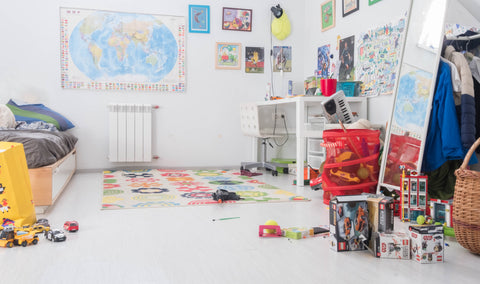
Photo by Igor Starkov / Unsplash
Decluttering the playroom involves:
- Sorting the toys based on their category.
- Discarding broken toys and toys sets with missing parts.
- Donating the toys that kids have outgrown or lost interest in.
- Giving the rest of them a designated place.
Repeat /once every three months.
-
SORT AND BOX THE TOYS:
Broken Toys:
Start sorting by removing broken toys. Next, pick out toy sets that have missing parts. These are of no use to anyone anymore. So, you don’t need to think twice. Go ahead and dispose of them. They should be the ones that go out first.
Outdated Playthings:
Toys meant for babies and preschoolers will be junk in an 8-year-old’s toy collection unless the kid or you hold an emotional bond to them. Though you can’t keep everything behind, you can save some keepsakes. If your kid is irrational, get rid of them by trading them for a treat or an outing.
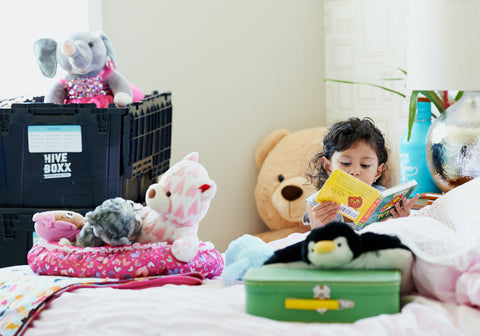
Expired Items:
Clear out the old clutter from the fresh ones – finished coloring books, broken crayons, old sketch pens, empty paint bottles, and others of the same kind. Trash them all.
Unappreciated Things:
Toy gifts that your kid has no interest in and toys that your kid finds boring can be donated to poor kids at shelters to bring a smile to their faces. The same applies to storybooks and other similar things.
-
ORGANIZE THE PLAYROOM
Now that all the unwanted bulk has moved out, you’d be surprised to see how much space you are now left with for storage. The room now looks more prominent and spacious, doesn’t it? That’s the sweet reward you get for the hard work and patience you’d invested in getting rid of the mess. It’s now time to categorize the rest.
Divide And Rule:
Yes, the best way to deal with them is to divide them according to the size, texture, and kind. Now, group them and store them.
For example, the stuffed toys can be put in one big basket or a hammock, while the racing car collection can go in a small plastic container. Reserve a plastic box for each transformer set and store all of them together in a bigger case. The scrapbook, scribbling pad, coloring pens and pencils, and all art supplies should be allotted a shelf, a cubicle, or a drawer.
Store the tiny tots like Shopkins and minion collection in small bins and the long ones like Lalaloopsies and Barbies in hanging pocket organizers that don’t take up much space.
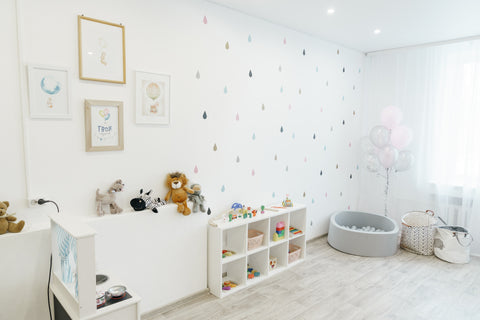
Photo by Алекке Блажин / Pexels
Display Biggies:
I’d always struggled to fit the weapons of war toys into the plastic cartons, as they never fit in quite right. That’s when it dawned on me – all things big and beautiful should be kept where the eyes can catch them. Yes, exhibit them all. Keep them on an open floating shelf or hang them on a pegboard, whatever is available in your home. Tanks and big cars can pose vividly on the playroom display.
Don’t labor packing the extra-large toys away. Giant stuffed dolls and dollhouses can sit in a corner and can be the star attraction. It’s time to show them off!
Use Wise Organizers:
Choose toy storage organizers that fit both in your budget and your space. Go for these see-through, vertical storage containers suited ideally for children’s small toys. When you use these easy-to-search toy bins, the kids can find their toys without emptying them and cluttering the room.
Book Nook:
Is your child always hooked to the tablet? Books are a great way to distract them from the gadget – i.e. if they have been trained from a young age to read.
Instilling reading habits in your child at a young age is better than buying them 100 toys. Spending time reading storybooks to your child helps them emotionally. In addition, reading develops their language skills and critical thinking.
So, I would encourage you to get as many books as possible for your kids and engage them in reading. It is a fantastic stress buster for children and has various other benefits. But we are decluttering, aren’t we?
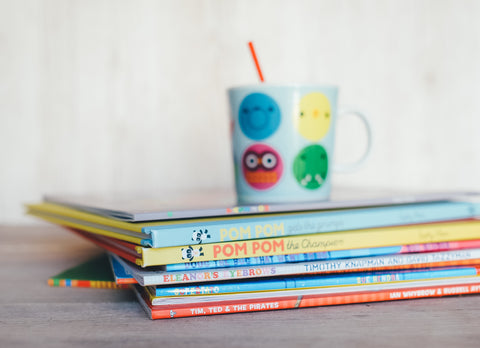
Photo by Annie Spratt / Unsplash
As your child grows, you can definitely give off the old books that aren’t age-appropriate to the needy. For example, that favorite alphabet and number book may still be looking as good as new but definitely is inappropriate in your 7-year-old’s bookshelf. As you get rid of the old ones, buy new books for your children (keeping the size of your bookshelf or library at home in mind, of course!) and keep them hooked to reading. Discard damaged and torn books if they’re irremediable. This will make space for the new ones.
Install bookshelves to display the books and create a mini library at home if you don’t have one. Books carry lovely memories in their own way. If there are way too many books, store the excess in boxes in the garage or storeroom. Rotate the book collection.
As your children grow older, allow them to purge their book clutter. Once they sort them out, either sell or donate them. Tell them this way they’ll have more space in their library and can now buy new ones. They’ll love you to the moon and back.
Label The Crates:
Label the boxes with pictures. You can actually download and print these from Google and paste it over the boxes. Also, teach your children to put back the toys they are playing with before picking up the next set of toys.
This way, they’ll be learning to tidy up as they finish playing without you actually telling them to clean up all the time.
If they mess up, don’t be angry. Since you’ve labeled the boxes, they can organize their toys themselves. Make it look like a fun game and engage them in the chore. Kids will learn to be responsible, and your work is also done.
Toy Rotation:
Do you have plenty of toys and don’t have the heart to give away precious memories? And you just don’t know what to keep and what to get rid of!
Don’t worry. You have company. It happens to all of us. Separate them into two groups. Store one set away in a carton box in the garage or basement for some time and use the other group. Swap them and use the other set after a few months, just as we did with the books. The toys will stay new and fresh, and your child will never be bored.
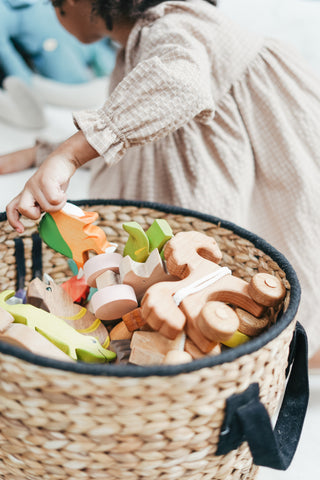
Now that we’ve sorted all the toys and organized them let’s look into keeping them so.
You have done your part, and the child now needs to be taught to keep their room tidy. It is not just about keeping their room orderly, but more importantly, life lessons are learned here at their playroom when they know to manage their things well.
PLAY AND LEARN:
We’ve come to a crucial place. We, as parents, are not clearing out our own clutter but that of someone else’s, viz our kids’. In short, we are sorting out someone else’s junk. This can be a sensitive task, and we can’t risk making mistakes. So, read on and tread carefully in this area.
Have a talk with your child:
If your child is not very young, ask your child’s opinion on which toys they are ready to give up. They’ll be prepared to part with some of their old toys, which they are no more interested in. Remove them first.
If the toys are good, donate them. Or, if you are putting up a garage sale or a yard sale, consider adding these trinkets to the lot. You might make a few bucks out of it.
But, for instance, if it is your personal favorite, or it is something that takes you down the memory lane, save it as a remembrance, as I said earlier.
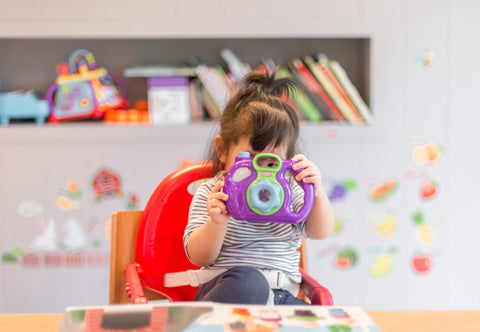
Photo by Tanaphong Toochinda / Unsplash
Child-Toy Psychology:
Do you think the more toys the kids have, the happier they are? No, that’s not true!
In fact, the more toys children have, the less they play with them. But, conversely, the lesser they have, the happier they are and more engaged when playing. It also helps them in their cognitive development.
Studies suggest that the lesser they have, children play with them in a more varied and imaginative way, thus paving a way to better learning.
Abstain from Binge Buying:
Even adults like us benefit from minimalism in so many ways. It is a great relief as it frees us from stress and helps us manage our time and things better.
Look around your kids’ room. Do they really need more toys? In all probability, they have all the toys they need and more. So, the next time you are out shopping, tell yourself that you really don’t need to buy them any toys.
One-In and Few-Out Rule:
But if you are very much inclined towards buying a new toy that you’ve promised for Christmas, follow the one-in and few-out rule. Yes, trade some old toys for a new one, and that way, they’ll be way more excited to part with the old ones. And you’ll do yourself a great favor.
Open-Ended Toys:
Take a break and sit back. Relax. Observe your kids play with their toys. Which toys keep them engaged, and for how long? Which toys help them to play together longer? Yes, that’s right. Open-ended toys. They’re truly unbeatable.
Magnetic tiles, Legos, wooden blocks, mini dolls and figurines, playdough, Slime, the list is endless, so are the creative ways to play with them. Not to mention how they benefit the children’s mental health and learning skills.
If your child is actively playing with their open-ended toy collectibles, know that you’re are in the right place.
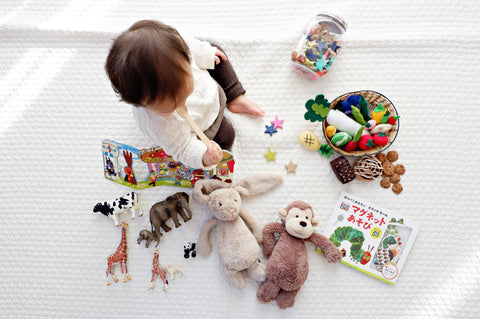
Photo by Yuri Shirota / Unsplash
Playing is Learning:
When children play, they are actually learning. When they are playing with open-ended toys, there are no rules and so no mistakes. They can stretch out in their own unique way. It inspires them without curbing their learning curve.
They learn to handle different circumstances, make their own choices, and are happy and motivated. It helps them express themselves. They are more adventurous, trying out endless possibilities and churning out fresh ideas all the time. These toys help them become the unique person that your child is meant to be.
Save Your Sanity:
Once you get rid of all the hoarded things, you’ll experience a happy, lighter feeling. The empty space in the playroom now looks inviting and friendly. Not just you, your kid also loves the playroom, as even kids experience stress with too many things around them that they don’t know to manage.
Think Out of the Box:
Yes, sending them out of the confined space of your home to play outside is truly a rewarding experience. Let them get out and enjoy the sun, wind, rain, sand, water, and nature and be free. There are endless possibilities for outdoor playing, and your children will enjoy it to the core. It is excellent for them and for us. However, keep a watchful eye on them, and check on them often to see if they are safe. Also, educate them on do’s and don’ts when playing outside and how to stay safe.
Dealing with toy clutter can be an absolute nightmare. But it is not something that can’t be tackled. With everything now put in order and plenty of space to play around for your kids, you have just shown your kid that you can do anything together. This inspires and motivates them to keep their place neat and tidy.
Great things always have small beginnings.

